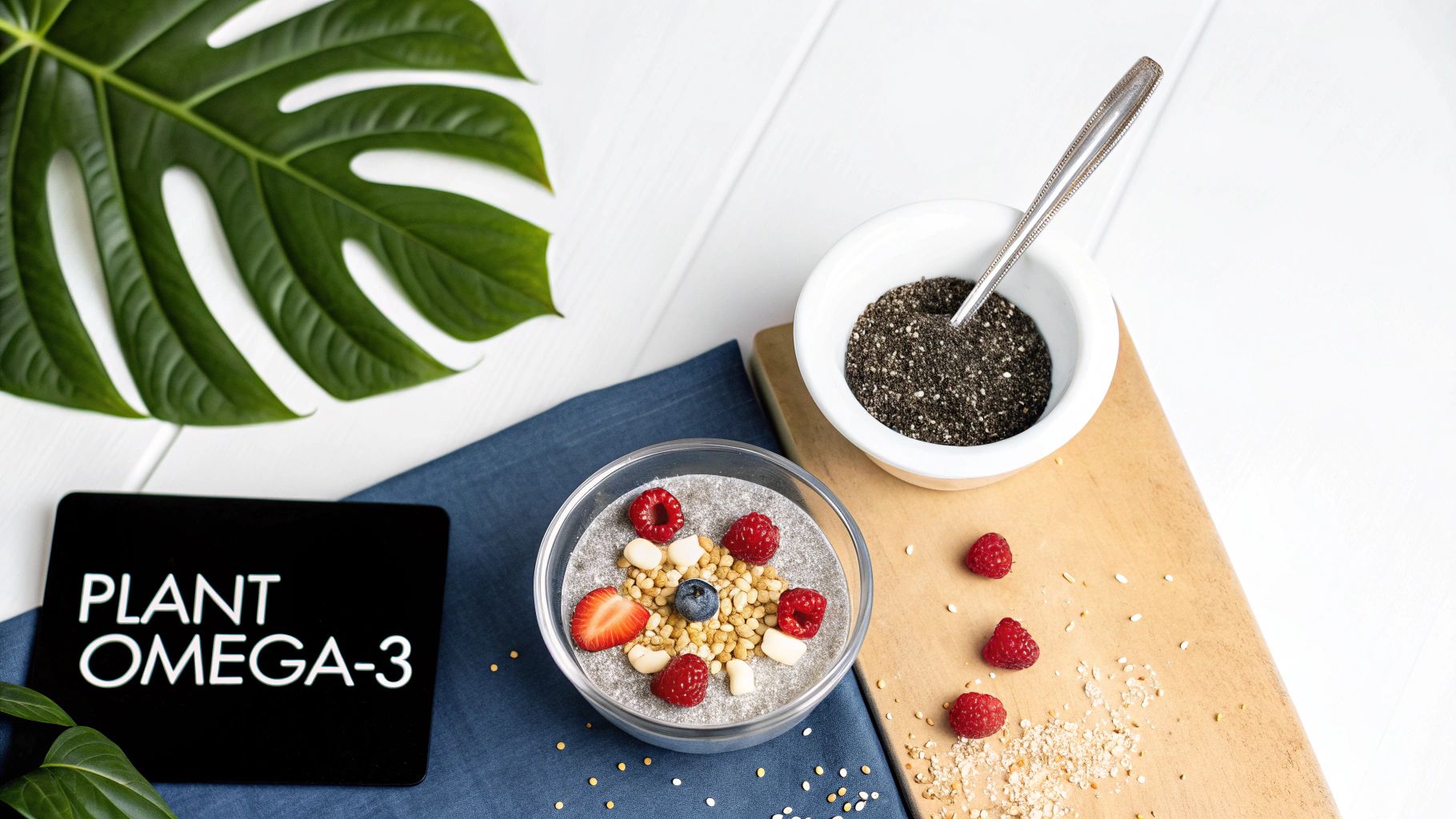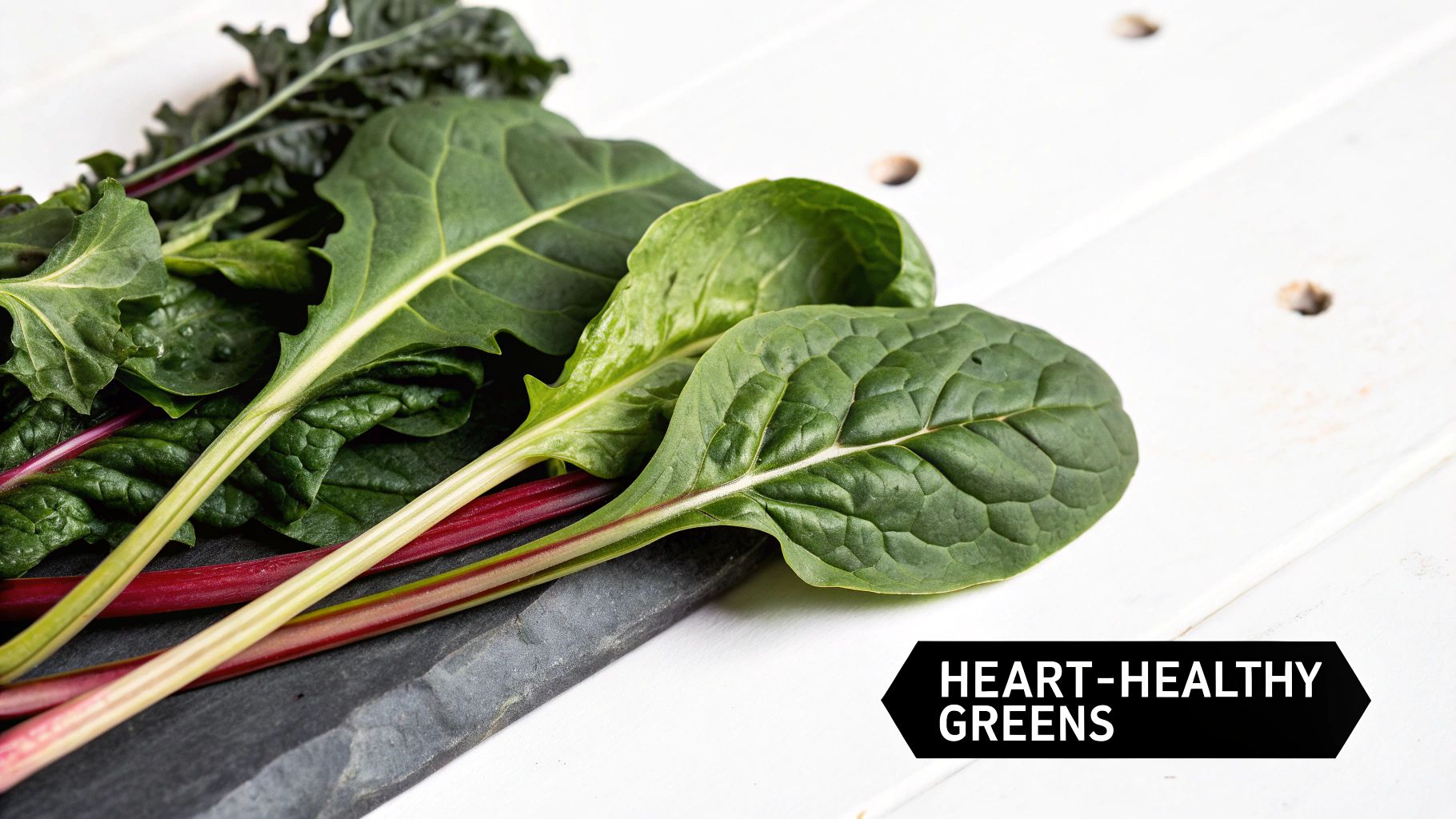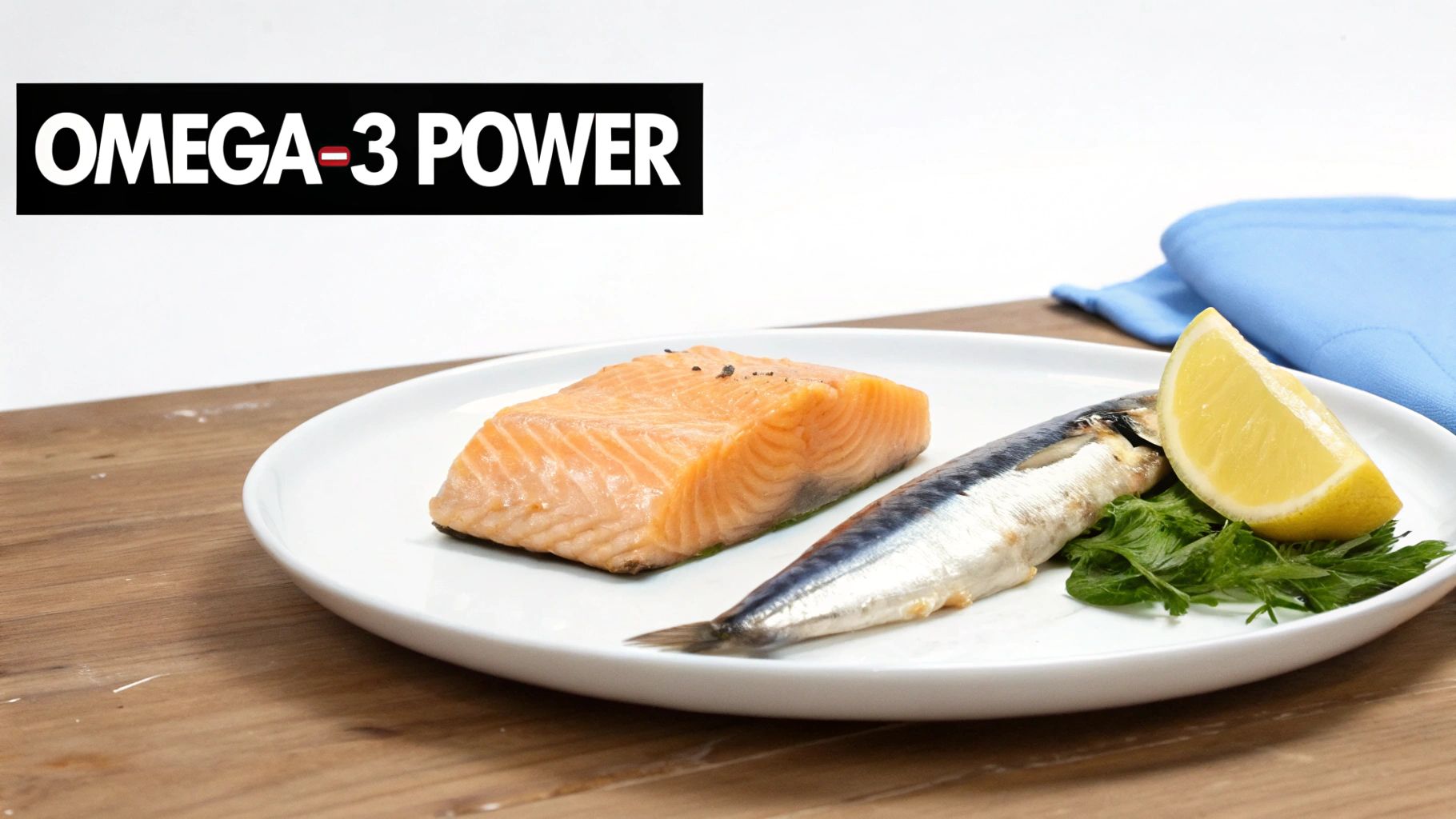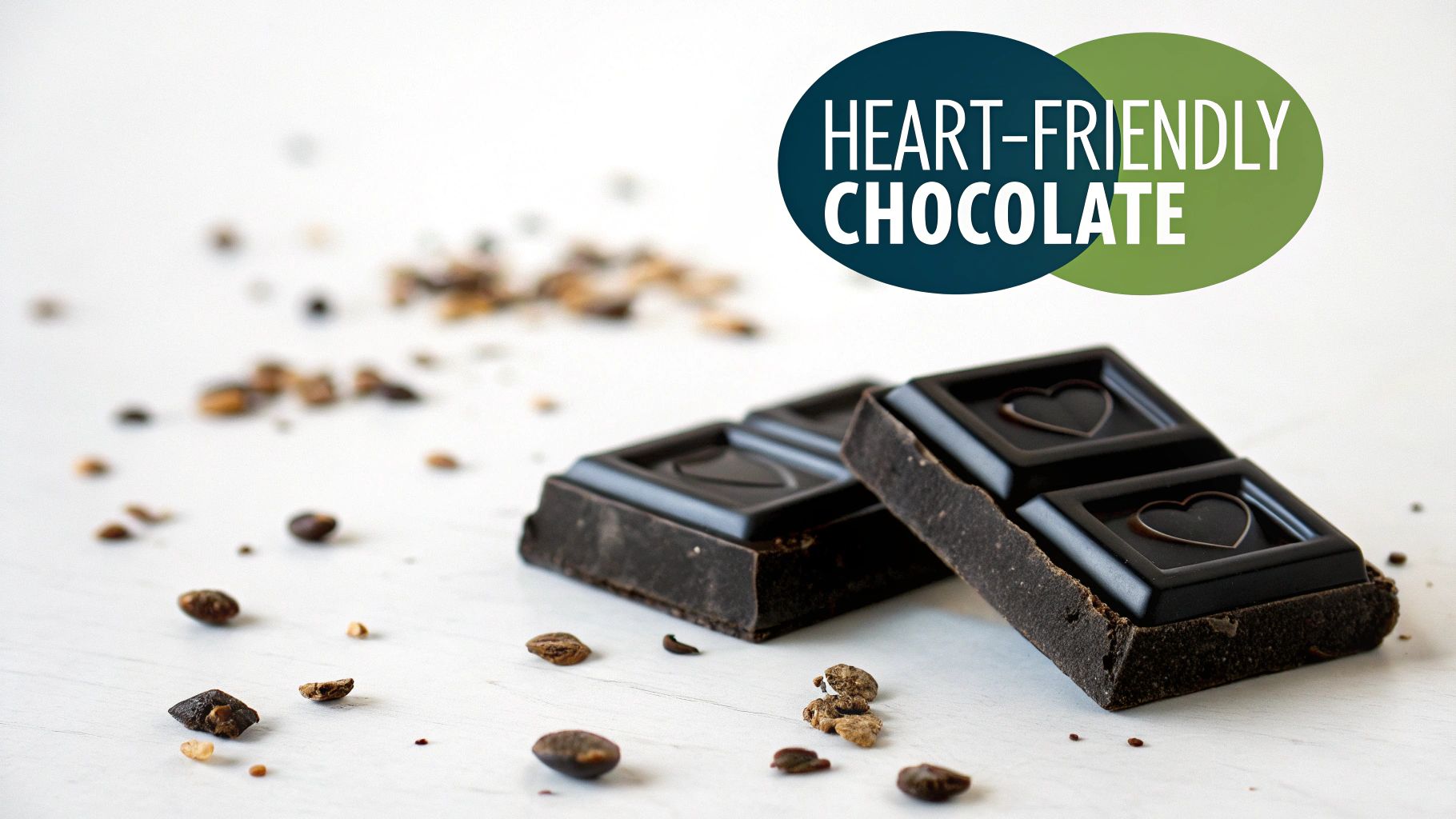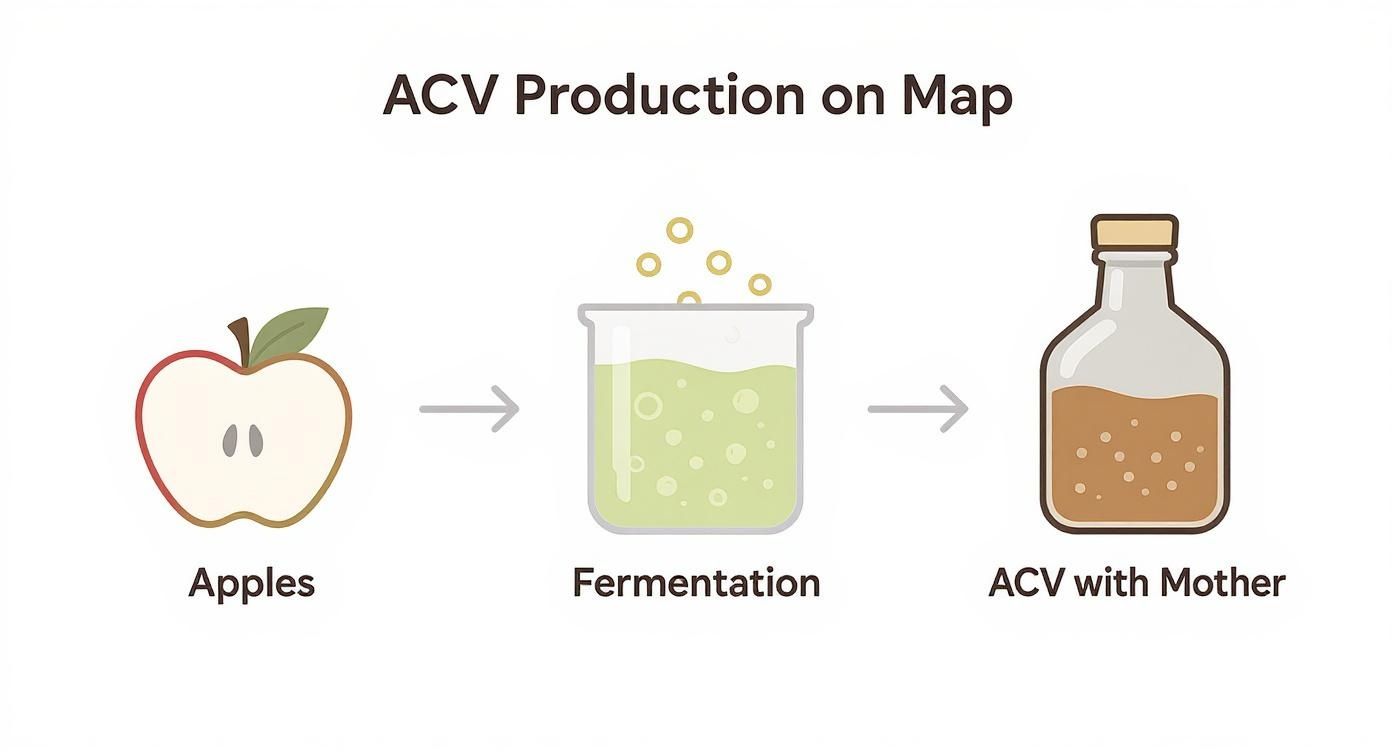Managing blood sugar levels can often feel like a complex puzzle, but one of the most powerful tools you have is right on your plate. While factors like genetics, activity levels, and stress play a role, the foods you choose every day have a direct and significant impact on glucose regulation. This isn't just a concern for those with diabetes; stable blood sugar is crucial for maintaining consistent energy, mental clarity, and long-term metabolic health for everyone.
This guide moves beyond generic advice to provide a clear, actionable roundup of the best foods for lowering blood sugar. We will explore ten powerhouse ingredients, from leafy greens and berries to fatty fish and avocados, each backed by scientific evidence. Instead of just telling you what to eat, we will dive into the specifics of how each food works to support glycemic control.
You will learn practical strategies for incorporating these foods into your daily meals, including optimal portion sizes, smart food pairings, and simple recipe swaps. We'll uncover the mechanisms behind their benefits, such as the role of fiber in slowing sugar absorption or how healthy fats can improve insulin sensitivity. Think of this not as a restrictive diet plan, but as a toolkit for building a blood-sugar-friendly eating style that is both sustainable and delicious. By understanding the power of these specific foods, you can take a proactive approach to managing your health, one meal at a time.
1. Leafy Greens (Spinach, Kale, Lettuce)
Leafy green vegetables are foundational to any diet focused on blood sugar management. Powerhouses like spinach, kale, collard greens, and various types of lettuce are exceptionally low in digestible carbohydrates, which means they have a negligible effect on blood glucose levels. Their low-calorie profile and high water content allow for generous portion sizes that promote fullness without the metabolic cost of a glucose spike, making them one of the best foods for lowering blood sugar over the long term.

The secret to their effectiveness lies in their composition. They are packed with insoluble fiber, which slows down digestion and the absorption of sugars from other foods in your meal. Furthermore, leafy greens are rich in polyphenols and vitamin C, antioxidants that have been shown to reduce inflammation and oxidative stress associated with diabetes complications. Certain compounds, like magnesium, are also abundant in greens and play a direct role in insulin sensitivity.
How to Implement Leafy Greens
Integrating these vegetables is simple and versatile. The goal is to make them a substantial part of your daily intake, not just a garnish.
- Make Them the Base: Build your meals on a foundation of greens. Start with a large salad using romaine, arugula, or mixed greens and then add your protein, healthy fats, and a small portion of complex carbs.
- Incorporate into Cooked Dishes: Wilt a few large handfuls of spinach into your morning omelet or scramble. Add chopped kale or collard greens to soups, stews, and pasta sauces for a nutrient boost without altering the flavor profile significantly.
- Blend into Smoothies: A handful of spinach blends seamlessly into a fruit smoothie, adding fiber and nutrients that help blunt the glycemic impact of the fruit.
Actionable Tips for Maximum Benefit
To get the most out of your leafy greens, consider not just what you eat, but how you eat it. Aim to fill at least half your plate with non-starchy vegetables like leafy greens at every meal. This "plate method" strategy naturally controls portions of carbohydrates and protein. Pair them with a source of healthy fat, like avocado or olive oil dressing, to enhance the absorption of fat-soluble vitamins (A, D, E, and K). Rotating the types of greens you eat ensures a wider variety of micronutrients and beneficial plant compounds.
2. Berries (Blueberries, Strawberries, Raspberries)
Berries are a vibrant and delicious way to satisfy a sweet tooth without causing a significant rise in blood sugar. Fruits like blueberries, strawberries, and raspberries are celebrated for their low glycemic index, which is largely due to their exceptionally high fiber content. This fiber slows the digestion and absorption of their natural sugars, preventing the sharp glucose spikes often associated with other fruits, making them a top choice among the best foods for lowering blood sugar.
The potent benefits of berries come from their unique phytochemical composition. They are rich in anthocyanins, a type of flavonoid that gives them their red, blue, and purple hues. Studies have shown that these compounds can improve insulin sensitivity and reduce post-meal blood sugar levels by inhibiting certain digestive enzymes. This powerful combination of fiber and antioxidants helps protect against the oxidative stress and inflammation that are common concerns in managing blood glucose.
How to Implement Berries
Adding berries to your diet is a simple swap that can have a big impact. The goal is to incorporate them strategically into meals and snacks where you might otherwise choose a higher-sugar option.
- Boost Your Breakfast: Add a ½ cup of blueberries or sliced strawberries to plain Greek yogurt or oatmeal. The protein and fat in the yogurt will further help stabilize your blood sugar response.
- Enhance Your Salads: Toss a handful of fresh raspberries into a spinach salad for a touch of sweetness and a boost of fiber that complements savory ingredients.
- Create Smarter Desserts: Enjoy a bowl of fresh strawberries with a dollop of unsweetened whipped cream for a satisfying, low-carb dessert that won't derail your blood sugar goals.
- Blend into Smoothies: Combine mixed berries with an unsweetened milk alternative, a scoop of protein powder, and a source of healthy fat like avocado for a balanced and blood-sugar-friendly smoothie.
Actionable Tips for Maximum Benefit
To get the full blood-sugar-stabilizing effects, portion control and pairing are key. Aim for a serving size of about ½ to 1 cup at a time. Always choose fresh or frozen berries without any added sugars or syrups. For the most balanced impact, pair berries with a source of protein or healthy fat, such as nuts, seeds, or yogurt. This combination slows down glucose absorption even more effectively. Finally, prioritize eating the whole fruit over drinking berry juice, which lacks the beneficial fiber and concentrates the sugar.
3. Legumes (Lentils, Chickpeas, Black Beans)
Legumes like lentils, chickpeas, and black beans are a cornerstone for blood sugar control due to their unique nutritional makeup. Despite containing carbohydrates, they boast a very low glycemic index, meaning they cause a much slower and smaller rise in blood glucose compared to other carb sources. This makes them one of the best foods for lowering blood sugar by promoting stability after meals. Their potent effect is largely due to a powerful combination of plant-based protein and high fiber content.
The fiber in legumes is particularly noteworthy. It includes both soluble fiber and resistant starch, which act together to slow down digestion and delay glucose absorption into the bloodstream. This slow-release mechanism prevents the sharp spikes and subsequent crashes that can wreak havoc on energy levels and insulin sensitivity. Furthermore, legumes are packed with essential minerals like magnesium and potassium, which are crucial for efficient insulin function and overall metabolic health.
How to Implement Legumes
Adding legumes to your diet is both affordable and versatile, with countless ways to incorporate them into your favorite meals. The key is to see them as a primary source of carbohydrates and protein.
- Swap for Refined Grains: Replace white rice or pasta with a serving of lentils or black beans. This simple swap significantly increases the fiber and protein content of your meal, improving its glycemic response.
- Boost Soups and Salads: Add a cup of chickpeas to a green salad for a satisfying texture and nutrient boost. Simmering red lentils into a vegetable soup makes it heartier and more filling.
- Use in Baking and Snacks: Use chickpea flour as a low-GI alternative in baking recipes for items like flatbreads or pancakes. Roasted chickpeas or homemade falafel make excellent high-fiber snacks.
Actionable Tips for Maximum Benefit
To get the most out of legumes while ensuring they agree with your digestive system, a little preparation goes a long way. If you are new to a high-fiber diet, start with small portions (e.g., a quarter cup) and gradually increase your intake to allow your gut to adjust. Soaking dried beans overnight before cooking can help reduce compounds that may cause gas and improve their digestibility. For convenience, canned legumes are a great option; just be sure to rinse them thoroughly to remove excess sodium.
4. Nuts and Seeds (Almonds, Walnuts, Flaxseeds, Chia)
Nuts and seeds are a powerful addition to a blood sugar-conscious diet. Varieties like almonds, walnuts, flaxseeds, and chia seeds are very low in carbohydrates while being rich in healthy fats, fiber, and plant-based protein. This potent combination of nutrients slows digestion and the release of glucose into the bloodstream, preventing the sharp spikes that can occur after a meal. Their impressive nutritional profile makes them one of the best foods for lowering blood sugar and improving long-term metabolic health.
The mechanism behind their benefit is multifaceted. The soluble and insoluble fiber in nuts and seeds creates a gel-like substance in the digestive tract, slowing carbohydrate absorption. Moreover, they are packed with magnesium and monounsaturated fats, which have been directly linked to improved insulin sensitivity. The healthy fats and protein also promote satiety, helping to control appetite and reduce overall calorie intake, which is crucial for weight management and stable blood glucose.
How to Implement Nuts and Seeds
Integrating these nutrient-dense foods is easy due to their convenience and versatility. The key is mindful portion control, as they are calorie-dense.
- Smart Snacking: Instead of reaching for crackers or chips, have a small handful of almonds or walnuts. Pair them with a piece of fruit to blunt the fruit's glycemic impact.
- Boost Your Breakfast: Sprinkle ground flaxseeds or whole chia seeds over oatmeal, yogurt, or cottage cheese. This adds fiber and healthy fats, keeping you full and your blood sugar stable all morning.
- Enhance Main Meals: Add a tablespoon of toasted walnuts or slivered almonds to salads or roasted vegetables for a satisfying crunch and a boost of healthy fats. Chia seed pudding also makes an excellent blood sugar-friendly breakfast or dessert.
Actionable Tips for Maximum Benefit
To fully leverage the benefits of nuts and seeds, strategic consumption is key. Aim for a serving size of about one ounce (roughly a small handful or 23 almonds) to manage calorie intake effectively. Choose raw or dry-roasted varieties and avoid those with added sugars, honey, or excessive salt. For seeds like flax, grinding them before consumption is essential to unlock their nutrients for absorption. Using various nuts and seeds ensures you get a broad spectrum of beneficial fats, vitamins, and minerals.
5. Non-Starchy Vegetables (Broccoli, Cauliflower, Bell Peppers)
Alongside leafy greens, other non-starchy vegetables form the cornerstone of a diet aimed at stabilizing blood sugar. Vegetables like broccoli, cauliflower, bell peppers, zucchini, and Brussels sprouts are defined by their low carbohydrate and high fiber content. This combination means they have a minimal, almost negligible, impact on blood glucose levels, allowing for generous portions that promote satiety without triggering an insulin response. This makes them one of the best foods for lowering blood sugar by displacing higher-carb items on your plate.
The power of these vegetables comes from their rich nutritional profiles. Broccoli and cauliflower contain sulforaphane, a compound linked to improved insulin sensitivity and reduced blood sugar production in the liver. Bell peppers are packed with vitamin C and antioxidants that help combat inflammation. Their high fiber content slows the overall digestion of your meal, ensuring a gradual release of glucose into the bloodstream rather than a sharp spike.
How to Implement Non-Starchy Vegetables
Integrating a wide variety of these vegetables is key to preventing dietary boredom and ensuring a broad spectrum of nutrients. The goal is to make them the most abundant food group in your diet.
- Create Smart Swaps: Use cauliflower rice or zucchini "noodles" in place of traditional grains and pasta. These substitutes provide a similar texture and bulk to meals but with a fraction of the carbohydrates.
- Roast for Flavor: Roasting vegetables like broccoli, Brussels sprouts, and bell peppers with a little olive oil, salt, and garlic brings out their natural sweetness and makes them a delicious side dish or meal component.
- Snack Strategically: Keep raw bell pepper strips, cucumber slices, and cherry tomatoes on hand for a crunchy, satisfying snack. Pair them with a healthy dip like hummus or guacamole for added protein and healthy fats.
Actionable Tips for Maximum Benefit
To truly leverage the benefits of non-starchy vegetables, focus on quantity and consistency. The "plate method" is an excellent visual guide: aim to fill at least half of your plate with these vegetables at every lunch and dinner. This naturally controls the portion sizes of starches and proteins. Cooking in bulk by roasting a large sheet pan of mixed vegetables at the beginning of the week ensures you always have a healthy, ready-to-eat option for quick meals. Experiment with different cooking methods like steaming, grilling, and stir-frying to keep your meals interesting and appealing.
6. Fatty Fish (Salmon, Sardines, Mackerel)
Fatty fish like salmon, sardines, and mackerel are a cornerstone of a blood sugar-stabilizing diet. As an excellent source of high-quality protein and healthy fats with zero carbohydrates, they have no direct impact on blood glucose levels. Their inclusion is crucial for anyone looking to manage their blood sugar, making them one of the best foods for lowering blood sugar by improving the body's overall metabolic function.
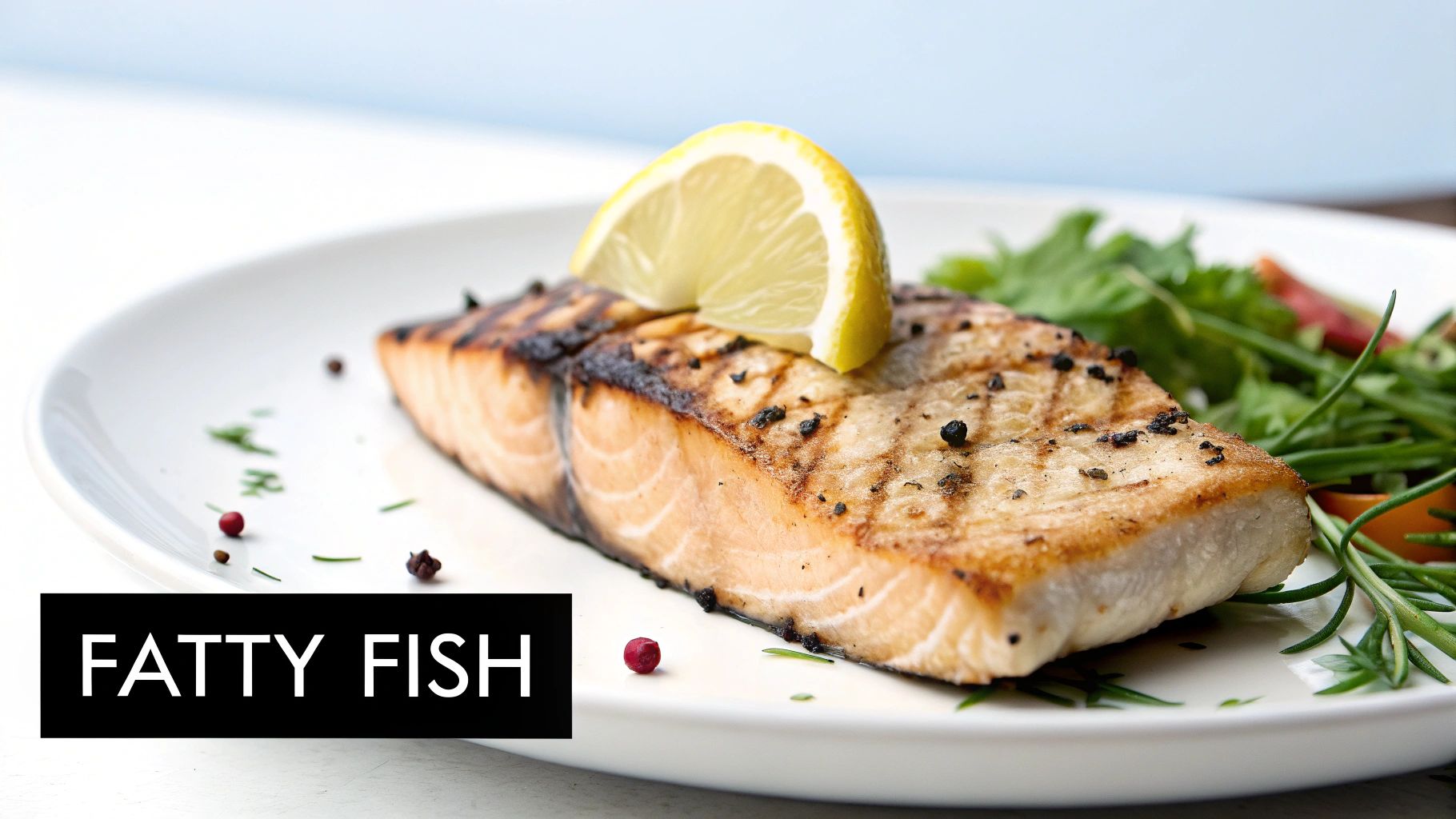
The primary benefit of fatty fish comes from their high concentration of omega-3 fatty acids, specifically EPA (eicosapentaenoic acid) and DHA (docosahexaenoic acid). These powerful fats are known to reduce inflammation, a key factor in insulin resistance. By improving insulin sensitivity, omega-3s help your cells use blood glucose more effectively. Furthermore, protein and fat are highly satiating, helping to prevent overeating and subsequent glucose spikes. Discover more about the benefits of omega-3s on healthdigest.blog.
How to Implement Fatty Fish
Incorporating fatty fish into your diet is a straightforward and delicious way to support your metabolic health. Aim for at least two servings per week to reap the benefits.
- Make it a Main Course: A grilled or baked salmon fillet paired with non-starchy vegetables makes for a perfectly balanced, low-glycemic dinner.
- Opt for Convenient Lunches: Canned sardines or mackerel are an affordable and easy option. Mix them with Greek yogurt and herbs and serve in lettuce wraps or with whole-grain crackers.
- Use in Salads: Flake leftover cooked salmon or use canned tuna (in water) to add a significant protein and healthy fat boost to your leafy green salads.
Actionable Tips for Maximum Benefit
To fully leverage the blood sugar benefits of fatty fish, focus on preparation and variety. Baking, grilling, or steaming are the best cooking methods, as frying can add unhealthy fats. When possible, choose wild-caught fish, which often has a superior omega-3 profile compared to farmed varieties. Don't be afraid of canned fish with the bones in; they are a fantastic source of calcium. Varying the types of fatty fish you consume, such as rotating between salmon, mackerel, and herring, helps ensure a broad spectrum of nutrients while minimizing potential exposure to mercury.
7. Eggs
Eggs are a powerhouse of nutrition and an exceptional choice for anyone focused on blood sugar control. As a food with virtually zero carbohydrates, they have no direct impact on blood glucose levels, making them a safe and stabilizing component of any meal. Their high-quality protein content is not only essential for muscle repair and maintenance but also plays a crucial role in promoting satiety, which helps prevent overeating and subsequent blood sugar spikes.
The benefit of eggs extends far beyond their macronutrient profile. They are a rich source of vital nutrients, including choline for brain health and lutein and zeaxanthin for eye health. Importantly, eating whole eggs provides healthy fats and nutrients found in the yolk that slow down digestion. This process helps moderate the absorption of any carbohydrates eaten alongside them, leading to a more gradual and controlled blood sugar response. Their affordability and versatility make them one of the most accessible and best foods for lowering blood sugar.
How to Implement Eggs
Integrating eggs into your diet is straightforward due to their incredible versatility. They can be a meal's centerpiece or a quick, satisfying snack.
- Start Your Day Strong: A vegetable-filled omelet or frittata offers a high-protein, low-carb breakfast that sets a stable blood sugar baseline for the day.
- Smart Snacking: Keep hard-boiled eggs in the fridge for a convenient, grab-and-go snack that curbs hunger without affecting glucose levels.
- Enhance Your Lunch: Add a sliced hard-boiled egg to your salads for extra protein or make a healthy egg salad using Greek yogurt or avocado instead of excessive mayonnaise.
- Creative Dinners: Bake eggs inside avocado halves or use them to top a bowl of sautéed vegetables for a simple, nutrient-dense meal.
Actionable Tips for Maximum Benefit
To fully leverage the blood-sugar-stabilizing power of eggs, focus on preparation and pairing. Aim for a serving of two to three whole eggs to achieve a significant level of satiety. Always pair them with fiber-rich, non-starchy vegetables like spinach, bell peppers, or broccoli to create a balanced, low-glycemic meal. Preparing a batch of hard-boiled eggs at the start of the week ensures you always have a healthy snack on hand. When possible, opt for pastured eggs, which may offer a higher concentration of omega-3 fatty acids and fat-soluble vitamins.
8. Avocados
Avocados are a uniquely potent food for blood sugar control due to their creamy texture, high nutrient density, and minimal carbohydrate content. Unlike most fruits, they are packed with healthy monounsaturated fats and fiber instead of sugar. This powerful combination significantly slows digestion and the absorption of glucose into the bloodstream, preventing the sharp spikes that can occur after a meal. Their richness in healthy fats also promotes satiety, helping to reduce overall calorie intake and support weight management, a key factor in improving insulin sensitivity.
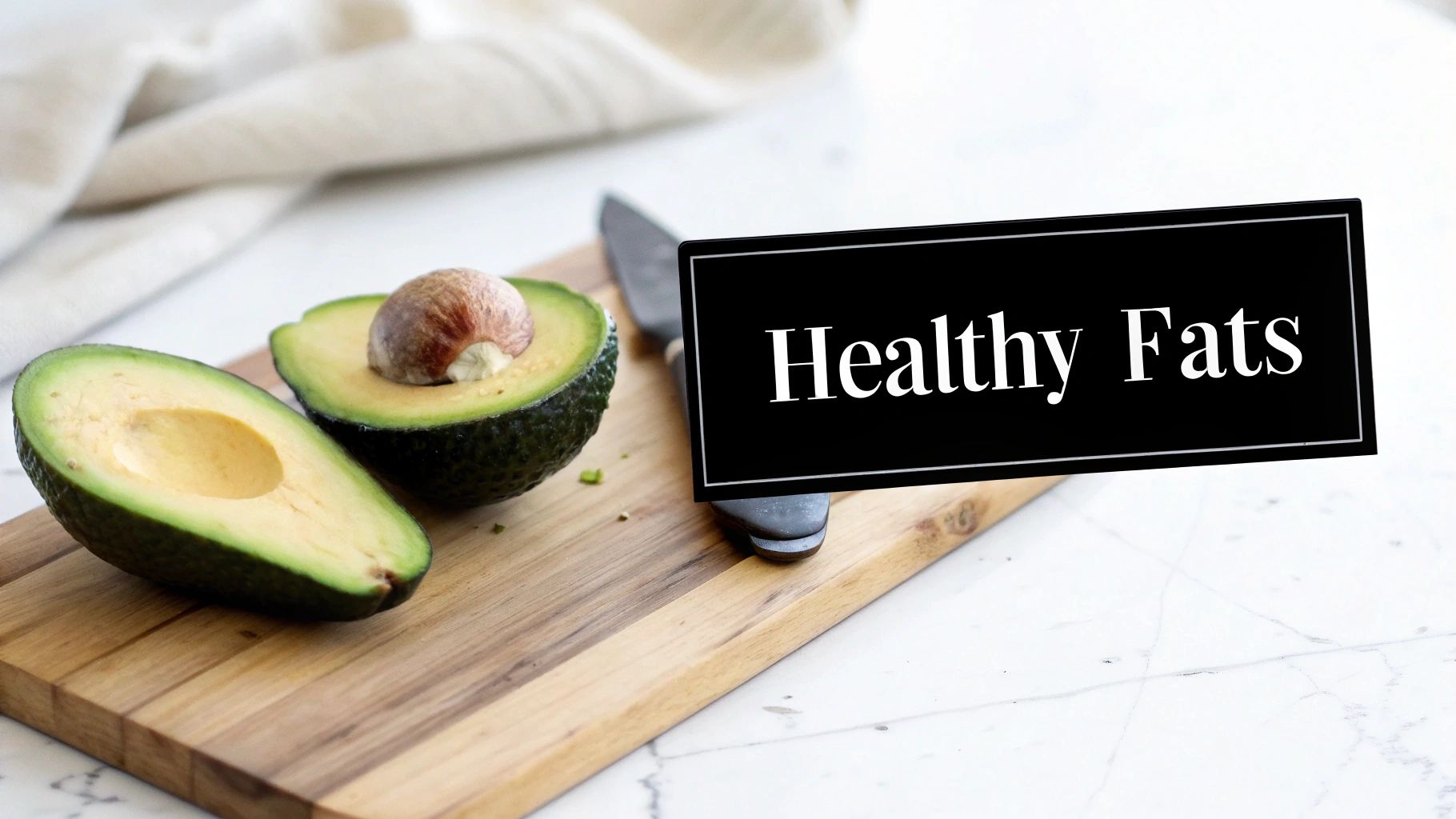
The magic of avocados lies in their composition. A single serving contains a substantial amount of fiber, which helps to stabilize blood sugar levels. Furthermore, the monounsaturated fats have been shown to improve insulin sensitivity and reduce inflammation. Avocados are also an excellent source of potassium, an essential mineral that plays a role in insulin function and glucose regulation, making them one of the best foods for lowering blood sugar.
How to Implement Avocados
Adding avocado to your diet is both simple and delicious, enhancing meals with flavor and powerful blood sugar-stabilizing benefits.
- Boost Your Breakfast: Add a quarter or half of a sliced avocado to your morning eggs or spread it on whole-grain toast in place of butter or jam.
- Create Smarter Snacks: Mash an avocado with lime juice and cilantro to create a healthy guacamole dip for non-starchy vegetables like bell peppers, cucumbers, or celery.
- Enhance Salads and Lunches: Top your salads with sliced avocado to add healthy fats that increase fullness and help absorb nutrients from other vegetables. A combination of avocado and grilled fish makes for a perfectly balanced, low-glycemic lunch.
- Use in Smoothies: Add a quarter of an avocado to your smoothie for a creamy texture and a dose of healthy fats and fiber that will blunt the glycemic impact of any fruit you include.
Actionable Tips for Maximum Benefit
To fully leverage the benefits of avocados, a few simple strategies can make a big difference. Portion control is key; aim for a serving size of one-quarter to one-half of an avocado to keep calories in check. To store a cut avocado, leave the pit in, sprinkle the exposed flesh with lemon or lime juice, and wrap it tightly to prevent browning. For cooking, consider using avocado oil, which has a high smoke point and a neutral flavor, making it a versatile choice for sautéing and roasting.
9. Greek Yogurt (Unsweetened, High-Protein)
Unsweetened Greek yogurt is a powerful dairy option for anyone focused on blood sugar control. Unlike conventional yogurt, it undergoes a straining process that removes most of the whey and lactose (milk sugar), resulting in a product that is significantly higher in protein and lower in carbohydrates. This high-protein content slows stomach emptying and promotes satiety, preventing the rapid blood glucose fluctuations that carb-heavy breakfasts often cause, solidifying its place among the best foods for lowering blood sugar.
The benefits extend beyond its macronutrient profile. Greek yogurt is a fermented food packed with probiotics, the beneficial bacteria that support a healthy gut microbiome. Emerging research suggests a strong link between gut health and metabolic function, including improved insulin sensitivity. As one of the most accessible fermented foods for longevity and health, its live cultures may help reduce inflammation and enhance the body's response to insulin over time. It is also an excellent source of calcium, which plays a role in glucose metabolism.
How to Implement Greek Yogurt
Choosing the right kind and incorporating it correctly is key to unlocking its blood sugar benefits. The goal is to use it as a protein-rich base rather than a sugary dessert.
- Build a Balanced Breakfast: Start your day with a bowl of plain, unsweetened Greek yogurt. Top it with a handful of berries for fiber and antioxidants, and a spoonful of chia seeds or chopped walnuts for healthy fats.
- Create Healthy Swaps: Use plain Greek yogurt as a direct substitute for sour cream or mayonnaise in dips, dressings, and sauces. This cuts down on unhealthy fats and adds a significant protein boost to your meal.
- Use in Cooking and Marinades: The acidity and enzymes in yogurt make it a fantastic tenderizer for chicken or fish. It can also add a creamy, low-carb texture to soups and curries without the need for heavy cream.
Actionable Tips for Maximum Benefit
To ensure your yogurt choice is helping, not hindering, your blood sugar goals, meticulous label-reading is essential. Always select plain, unsweetened varieties, as flavored versions often contain surprisingly high amounts of added sugar. If you need sweetness, add it yourself with a sprinkle of cinnamon, a few drops of vanilla extract, or a small portion of low-glycemic fruit. Pairing it with sources of fiber and healthy fat, like nuts and seeds, further slows glucose absorption and creates a more complete, stabilizing meal.
10. Vinegar (Apple Cider and Balsamic)
Vinegar, especially apple cider and balsamic varieties, is a surprisingly effective tool for blood sugar management. Its primary active compound, acetic acid, has been shown in studies to significantly improve insulin sensitivity and lower the blood glucose response after a meal. This makes vinegar one of the most accessible and best foods for lowering blood sugar, working by slowing down the rate at which the stomach empties and inhibiting the enzymes that digest starches.
The mechanism behind vinegar's power is its ability to directly influence carbohydrate metabolism. By temporarily slowing digestion, it blunts the sharp spike in glucose that typically follows a carb-rich meal, promoting a more gradual and manageable rise. This effect not only helps in the short term but also supports better long-term glycemic control by reducing the overall demand for insulin. Learn more about the numerous benefits of apple cider vinegar for a deeper understanding.
How to Implement Vinegar
Adding vinegar to your diet is simple and can be done in ways that enhance the flavor of your food rather than detract from it. The key is to consume it with or just before your meals.
- Create Vinaigrettes: The most popular and palatable method is to make a simple vinaigrette with olive oil, herbs, and 1-2 tablespoons of apple cider or balsamic vinegar to dress salads and roasted vegetables.
- Drink it Diluted: For a more direct approach, mix one to two tablespoons of apple cider vinegar in a large glass of water and drink it just before you begin eating your meal.
- Incorporate into Marinades and Sauces: Vinegar is a great tenderizer for meats and adds a bright, acidic note to marinades, sauces, and soups.
Actionable Tips for Maximum Benefit
To use vinegar safely and effectively, a few guidelines are essential. Always dilute vinegar in water or incorporate it into food; drinking it straight can damage your tooth enamel and esophagus. If you choose to drink it, using a straw can help minimize contact with your teeth. Start with a small amount, like one teaspoon, to see how your body responds before increasing to one or two tablespoons per meal. This simple addition, particularly before your largest or most carbohydrate-heavy meal of the day, can make a noticeable difference in your post-meal glucose readings.
Top 10 Blood-Sugar-Lowering Foods Comparison
| Item | 🔄 Implementation complexity | ⚡ Resource & prep efficiency | 📊 Expected outcomes | 💡 Ideal use cases | ⭐ Key advantages |
|---|---|---|---|---|---|
| Leafy Greens (Spinach, Kale, Lettuce) | Low 🔄 — minimal prep (wash/chop) | High ⚡ — inexpensive, widely available | Improves insulin sensitivity; minimal glucose impact 📊 ⭐⭐⭐ | Salads, smoothies, sides | Very low carbs, high fiber & micronutrients ⭐ |
| Berries (Blueberries, Strawberries, Raspberries) | Low 🔄 — ready-to-eat or rinse | Moderate ⚡ — short shelf life; frozen option | Low glycemic impact; anti-inflammatory effects 📊 ⭐⭐ | Yogurt topping, snacks, smoothies (portion-controlled) | Low-sugar fruit, rich in antioxidants ⭐ |
| Legumes (Lentils, Chickpeas, Black Beans) | Moderate 🔄 — soaking/cooking often required | Moderate ⚡ — affordable, shelf-stable but time-consuming | Stable blood sugar; sustained energy and satiety 📊 ⭐⭐ | Soups, stews, salads, plant-based protein dishes | High fiber/protein, nutrient-dense ⭐ |
| Nuts & Seeds (Almonds, Walnuts, Flax, Chia) | Low 🔄 — ready-to-eat; minimal prep | High ⚡ — portable, long shelf life but calorie-dense | Improve satiety; minimal glycemic effect 📊 ⭐⭐ | Snacks, toppings, smoothies | Healthy fats, low net carbs per serving ⭐ |
| Non-Starchy Vegetables (Broccoli, Cauliflower, Peppers) | Low 🔄 — simple cooking or raw | High ⚡ — cheap, versatile, water-dense | Virtually no glucose impact; micronutrient support 📊 ⭐⭐⭐ | Bulk meal component, sides, grain substitutes | Extremely low carbs, high fiber & vitamins ⭐ |
| Fatty Fish (Salmon, Sardines, Mackerel) | Moderate 🔄 — cooking/sourcing required | Moderate ⚡ — perishable; can be costly | Strong anti-inflammatory and cardiometabolic benefits 📊 ⭐⭐⭐ | Main protein source, omega-3 focused meals | Zero carbs, rich in EPA/DHA & complete protein ⭐ |
| Eggs | Low 🔄 — very easy to prepare | High ⚡ — inexpensive, versatile | No blood sugar impact; high satiety & muscle support 📊 ⭐⭐⭐ | Breakfasts, quick meals, snacks | Complete protein, nutrient-dense, versatile ⭐ |
| Avocados | Low 🔄 — minimal prep; ripening management | Moderate ⚡ — calorie-dense and pricier | Stabilize blood sugar; promote satiety & healthy lipids 📊 ⭐⭐⭐ | Salads, spreads, healthy-fat additions | High monounsaturated fat, fiber, micronutrients ⭐ |
| Greek Yogurt (Unsweetened, High-Protein) | Low 🔄 — ready-to-eat (choose plain) | High ⚡ — refrigerated; careful label selection | Improves insulin sensitivity via protein & probiotics 📊 ⭐⭐ | Breakfast, dips, parfaits | High protein, probiotics, low carbs when unsweetened ⭐ |
| Vinegar (Apple Cider & Balsamic) | Very Low 🔄 — simply add/dilute | High ⚡ — inexpensive, shelf-stable | Reduces post-meal glucose spikes (≈20–30%) 📊 ⭐⭐ | Vinaigrettes, pre-meal dilute drink, marinades | Low-cost, evidence-backed glucose reduction ⭐ |
Building a Sustainable Blood Sugar-Friendly Lifestyle
Navigating the world of nutrition to manage blood sugar can feel complex, but as we've explored, the power to create a positive impact lies right on your plate. This journey isn't about deprivation or overly restrictive diets; it's about empowerment through strategic, delicious choices. By understanding the best foods for lowering blood sugar, you are equipping yourself with the tools to build a resilient, health-conscious lifestyle.
We've covered a diverse lineup of nutritional powerhouses, from the fiber-rich resilience of leafy greens and legumes to the healthy fats found in avocados, nuts, and fatty fish. Each food offers a unique mechanism for blood sugar control, whether it's slowing glucose absorption, improving insulin sensitivity, or providing a steady release of energy without the dramatic spikes. Remember, the goal is not just about what you remove from your diet, but what you intentionally and joyfully add.
Key Takeaways: From Knowledge to Action
The most effective strategy is a holistic one that combines these foods into a balanced and sustainable eating pattern. Let's distill the core principles from this guide into actionable takeaways that can transform your daily habits.
The Power of Pairing:
One of the most crucial lessons is that context matters. A carbohydrate, when eaten alone, will have a very different impact on your blood sugar than when it's paired with protein, fiber, and healthy fats.
- Before reaching for fruit, consider adding a handful of almonds or a spoonful of chia seeds.
- When enjoying whole grains, ensure a serving of fatty fish or a hard-boiled egg is on the same plate.
- Think of fiber and protein as your "blood sugar buffers." They act as the braking system for glucose release, promoting a gentle curve rather than a sharp peak and subsequent crash.
Consistency Over Perfection:
Building a blood sugar-friendly lifestyle is a marathon, not a sprint. You don't need to overhaul your entire diet overnight. Small, consistent changes create the most significant and lasting impact.
- Start by incorporating one new food from our list each week.
- Focus on one meal at a time. Perhaps you start by optimizing your breakfast with Greek yogurt and berries, then move on to redesigning your lunch the following week.
- Don't let a single off-plan meal derail your progress. Acknowledge it and get right back to your goals with your next meal. The long-term pattern is what truly shapes your health.
Beyond the Plate:
While this guide focuses on the best foods for lowering blood sugar, remember they work best within a supportive lifestyle. Adequate sleep, regular physical activity, and stress management are all powerful allies in your quest for stable glucose levels. A brisk walk after a meal, for instance, can significantly improve how your body utilizes the glucose from that food.
Key Insight: True mastery over blood sugar management comes not from rigid rules, but from understanding the principles of how different foods interact with your body. It's about building a flexible toolbox of strategies-pairing foods, timing meals, and making smart swaps-that you can adapt to any situation.
Ultimately, integrating these foods into your diet is a profound act of self-care. It's an investment in your long-term vitality, energy levels, and overall well-being. By making these mindful choices, you are not just managing a number; you are nourishing your body from the inside out, paving the way for a healthier, more vibrant future.
For more evidence-based guides and actionable wellness tips to support your health journey, explore the resources at Health Digest. Our mission is to provide clear, practical information to help you build sustainable habits, from nutrition to lifestyle. Discover your path to better health at Health Digest.
Article created using Outrank











